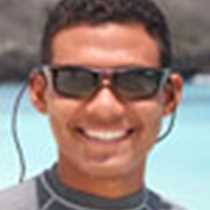The Galapagos originated from a hot spot, a place beneath the ocean where magmatic activity is still forming new land. Eventually after submarine eruptions, the volcanoes reached the surface of the ocean and created land. These islands’ weather and sustainability is ruled by oceanic currents. All the species of plants, birds, reptiles, fish and others were carried to a place where they later changed and became new species.
Today the National Geographic Islander traveled to the oldest island in the Galapagos, Española.
It has two visitor sites; the east coast which is relatively calm and offers shelter for land birds and some other animals, and the west where seabirds breed.
During the morning we visited a bay called Gardner. Some guests were quite active, so early before breakfast we deployed the kayaks to be the first to visit the island. We encountered some iguanas and sea turtles. Later some of us visited an islet where we could snorkel with baby sea lions and turtles. Some others went to the beach, one of the most beautiful in the Galapagos.
Later onboard, we enjoyed Ecuadorian food. We had a traditional Ecuadorian buffet lunch with foods from the highlands, coast and amazon region to showcase the varied cuisine of Ecuador.
In the afternoon we visited Punta Suarez. Around this end of the island there is a breeding colony of different species of birds and other animals. As soon as we landed baby sea lions were waiting, playing while their mothers were out fishing in the ocean. Marine iguanas at this time of the year nest and display bright colors, giving them their nickname, “Christmas iguanas”. Also the biggest species of booby, the Nazca booby, breeds with the males dancing to find their mate for the year.
Española was a wonderful stop before we continued our trip.







